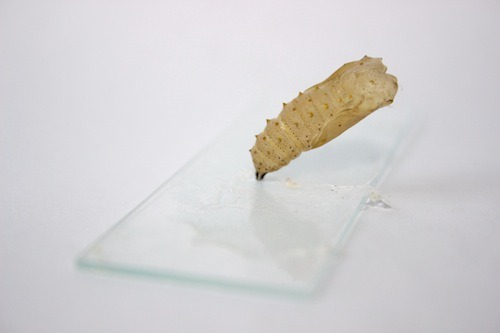Jessica Ann, shares her thoughts as an artist engaging animals in her research as an MFA candidate in the Department of Art at the Ohio State University. 
Looking, thinking, and meeting animals is a tumblr blog documenting animal interactions and research, including some of my own. I have been looking closely at the life cycle of the Vanessa cardui (painted lady butterfly), in particular the moment of the chrysalis. I am interested in the potential for human/insect/machine amalgamation during this phase.Research is ongoing. On the theoretical end of my investigations I have become quite sensitive to the effects that accompany the act of looking-animals. It is important for me to offer a hyphen between the words looking and animals, in lieu of a preposition for example. If I were to say “looking at animals” my language would then dictate a particular proximity between the agential “looking human animals” and the non-agential “non-human animals”. The term looking-animals offers some kind of alternative terminology for framing my relationship to the organisms I study. I want to recognize, with my work, but first with my language, 1) the agency of other organisms, 2) the effects of looking, and 3) how other organisms and myself actually meet in the middle somewhere, looking at and effecting each other. With my research I hope to help (re)configure a world where the line between animals and humans can be replaced with something more interesting, and more helpful for us both.
LOOKING
Where the pavement ends and the Olentangy River wetlands begin you might find a nice concrete slab to sit and think. It is not very comfortable, but it seems better than sitting on damp dirt on its way to mud. Upon arrival you take a deep breath, cross your feet, maybe light a cigarette. A few puffs in and things start to get weird. The ground you thought lay still before you starts moving. First you notice there are hundreds of ants scurrying all around the edges of the concrete slab. They are big enough you can see their impressive mandibles. Then you notice smaller ants, and then even smaller ants, you cannot see their jaws but you know they are there. A wasp lands on a nearby leaf, rubs its forearms together, wiggles its thorax, does it again. Insects of all shapes and sizes begin to reveal themselves up and down sticks, over and under leaves, buzzing all around, you are definitely not alone. Many scales of being come into focus, and this is only the macro level. You realize yourself “swept up in the generative currents of the world” (Ingold, 2010 95).
THINKING
My approach to thinking about insect worlds in motion on a concrete slab has been influenced by Tim Ingold’s essay The temporality of the landscape. Ingold is interested in articulating anew our language for thinking in relationship to the landscape. I say “thinking in relationship” as an alternative to “thinking about our relationship”. The former seems closer to Ingold’s intent to acknowledge that the relationship between beings made of matter and matter is always in the making. “Our relationship” to the landscape is not a fixed thing we can muse on about because our very musing, (archeology for example), has performative effects. So we must think in relationship to the landscape. Ingold does this by issuing a theoretical framework that reconstitutes dualistic notions of agent/taskscape and land/landscape into a more productive arrangement he terms “the dwelling perspective”. There is much to be explicated here, I will save that work for another platform. At present it lives as a paper-in-progress: “Taskscape/Landscape Intra-activity”.
MEETING
While I work through these ideas I converge daily with animals, organisms and matter; at times I organize the interactions (my in-studio experiments with butterfly chrysalis), other times they are unsolicited (the skunk I have seen creeping around campus at midnight, twice now). The more time I spend thinking the more I like the looking. Eventually, I hope to find a productive way for the meeting. In the meantime projects like Biopresence serve as a platform for looking without imposing; and bringing the conversation about our proximity to animals into view.
–
Ingold, Tim. “The Temporality of the Landscape.” World Archaeology 25.2 (1993): 152-74.
Ingold, Tim. “The Textility of Making.” Cambridge Journal of Economics 34.1 (2010): 91-102.